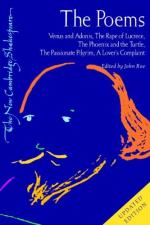|
This section contains 3,193 words (approx. 11 pages at 300 words per page) |

|
SOURCE: 'The Dead Phoenix," Essays in Criticism, Vol. XV, No. 3, July, 1965, pp. 279-87.
In the essay that follows, Copland criticizes a mystical interpretive approach to the poem, given the "fashionable" status of metaphysical images in the Elizabethan age.
The Phoenix was a striking bird on three counts: (a) its beauty, (b) its uniqueness, and (c) its self-resurrecting habit.
In Shakespeare's poem The Phoenix and Turtle the attribute (a) is prominently present:
Truth and Beautie buried be.
Here Truth = the Turtle, and Beautie = the Phoenix.
As for (b), Robert Chester, whose Love's Martyr prescribed the bare postulates for the poem, had introduced a personal variation of a certain imaginative power. The usual Phoenix is complete in itself; Chester's requires a mate, and finds that mate in a true Turtle. This is not necessarily a muddling idea. If the Phoenix is seen as a poetic hyperbole for the summit of...
|
This section contains 3,193 words (approx. 11 pages at 300 words per page) |

|


